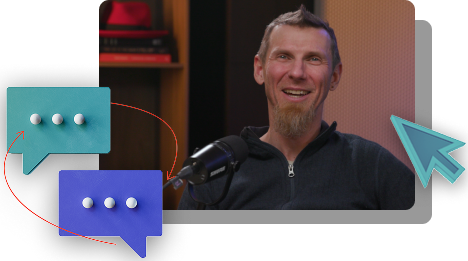
This video can't play due to privacy settings
To change your settings, select the "Cookie Preferences" link in the footer and opt in to "Advertising Cookies."
Edge IT: A Space Odyssey
How do you manage IT operations at the edge? Open the pod bay doors, Chris. Stefanie Chiras, Senior VP and General Manager for Red Hat Enterprise Linux, drops in to chat about how edge computing is changing how businesses operate IT infrastructure and services. For the growing number of devices, sensors, applications, and data residing at the edge, uncertainty may be a fact of life, but with the right telemetry data, IT operations teams can arm themselves against uncertainty and better predict issues before they become outages.
자막
Transcript
00:01 - Chris WrightWow, man. The Mars Rover has to be one of the edgiest of edge devices. What happens when you need to push updates? I mean, there's no 5G in space. NASA must be used to dealing with an amount of uncertainty that for a guy like me who lives more in a data center or the cloud, it would be really nerve-wracking to operate and monitor compute nodes millions of miles away. What does it even mean to operate at the edge?
00:28 - INTRO ANIMATION
00:38 - Chris Wright
One of the things that eases tensions when operating compute nodes in far away and scary places is the ability to monitor them with telemetry data. Telemetry is the collection of measurements or other data at remote points. Telemetry is based on instrumentation and gives you observability into complex systems. It's used to monitor device utilization, the performance of applications and provides system feedback. Telemetry produces a stream of events to monitor the system and that insight provides the impetus to automate a response. Oh, Hey Stefanie, how's it going?
01:21 - Stefanie Chiras
Hey Chris.
01:22 - Chris Wright
Hey, I was just checking in. I thought that last meeting went okay, but I just wanted to make sure you were feeling good about it or if you had any follow-ups or anything from that call?
01:32 - Stefanie Chiras
Yeah, you know, I did think it went pretty well.
01:22 - Chris Wright
I gotta admit I was just actually looking at some Mars rover's pictures and it's amazing. I can't help but think about what a challenge it would be to manage devices you know, edge devices like, like rovers.
01:49 - Stefanie Chiras
It's like having that remoteness has this like whole new layer of fear and uncertainty. How do I know? Is it going okay? I don't have an IT team standing next to it to take care of it.
02:00 - Chris Wright
It's true I mean, it's a leap of faith and I think, I don't know, one of the things that I think helps is creating some visibility or observability.
02:11 - Stefanie Chiras
You know, you take that distance and that uncertainty and then you apply it over a broad number. You can't monitor tens of thousands of unique things. So now you have to figure out what is that baseline? So you can say okay, if I don't hear anything, it's probably running okay, cause I know what a watermark is for that visibility but then, I know when something blips up, it's like, okay, that's where I can focus my attention on. That at least gives you a sense of comfort because there's no way you can monitor everything uniquely all the time.
02:40 - Chris Wright
Yeah, I think that's a great point. Having that telemetry data or that stream of information associated with the devices, looking for anomalous behavior, is a way that we can then trigger automation to bring back the system to a standard operating model that consistent baseline that we've kind of identified, and we understand as this, you know, these edge devices can look more and more appliance-like.
03:07 - Stefanie Chiras
Yeah, I mean, you have to know that what you start with is set to run at that normal, you know, that new normal. So, I think we're seeing that in a lot of areas in it though, right? Even in an operating system, being able to deploy an immutable image so knowing, I know it was put out there, I know it's going to stay that way. That becomes part of setting up that standard of having something that's consistent. It's the same thing with containerization and the beauty of containerization of applications, right? You build the container once, you deploy it once or you deploy it 10,000 times, it's deployed the same way.
03:41 - Chris Wright
That's a great point, I love that connection between what we've learned in cloud-native development and the immutable images of containers, you don't log in, you don't SSH into your container and RPM update packages, you rebuild the image and you redeploy, and that same concept really critical when we talk about the edge I mean, I don't know, I think, bringing the operations teams together probably requires some consistency in not just how we build and deliver the applications but the kind of the common framework for that whole picture of streaming content or streaming observability data and the remediation with automation and that sounds a lot like a common language or a common mechanism for broad groups to coordinate it.
04:31 - Stefanie Chiras
I think it works on, on all the levels that we're looking at here in IT, especially around edge you know, you get that common, that baseline that we talked about of how you actually deploy your edge. Then you got that common kind of way to communicate or assess the data they get sent back and that's across your it team but then even in a market level or even at a technology level, it's that consistency, so that the network knows what to expect from the hardware that the operating system, knows what to expect from the applications, that you know, your networking team knows what to expect from the ops team. It's like having some way to communicate and a set of like, kind of just expectations that baseline of communication is critically important, otherwise you're recreating all the time. Oh shoot, Chris, I got to run, I totally missed the time. I know this could happen every time I call you, but anyway, loved chatting, but I gotta bolt.
05:30 - Chris Wright
All right, thanks Stefanie.
05:32 - Stefanie Chiras
I'll talk to you later. See ya.
05:34 - Chris Wright
Cheers. With scale and consistency fundamental to edge computing, How do we think about ops management differently? It's less about synchronous management and more about asynchronous. We're going to get too much information and we have to be ready to respond to the anomalous behaviors. And when devices and sensors have to be spread further over huge even inaccessible areas like assembly lines, subterranean wells, along railroad tracks for thousands of miles or in the deep reaches of space, consistency and predictability become mission critical.
06:08 - OUTRO ANIMATION
About the show
Technically Speaking
What’s next for enterprise IT? No one has all the answers—But CTO Chris Wright knows the tech experts and industry leaders who are working on them.
